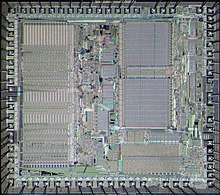
Back Motorola 68000 Catalan Motorola 68000 Czech Motorola 68000 German Motorola 68000 Greek Motorola 68000 Spanish موتورولا ۶۸۰۰۰ Persian Motorola 68000 Finnish Motorola 68000 French Motorola 68000 Croatian Motorola 68000 Hungarian
| Designer | Motorola |
|---|---|
| Bits | 16/32-bit |
| Introduced | 1979 |
| Design | CISC |
| Branching | Condition code |
| Endianness | Big |
| Registers | |
| |
| General information | |
|---|---|
| Launched | 1979 |
| Discontinued | June 1, 1996 |
| Designed by | Motorola |
| Performance | |
| Max. CPU clock rate | 4 MHz to 16.67 MHz |
| Data width | 16 bits |
| Address width | 24 bits |
| Architecture and classification | |
| Instruction set | Motorola 68000 series |
| Physical specifications | |
| Transistors |
|
| Package |
|
| History | |
| Successor | Motorola 68010 |
The Motorola 68000 (sometimes shortened to Motorola 68k or m68k and usually pronounced "sixty-eight-thousand")[2][3] is a 16/32-bit complex instruction set computer (CISC) microprocessor, introduced in 1979 by Motorola Semiconductor Products Sector.
The design implements a 32-bit instruction set, with 32-bit registers and a 16-bit internal data bus.[4] The address bus is 24 bits and does not use memory segmentation, which made it easier to program for. Internally, it uses a 16-bit data arithmetic logic unit (ALU) and two more 16-bit ALUs used mostly for addresses,[4] and has a 16-bit external data bus.[5] For this reason, Motorola termed it a 16/32-bit processor.
As one of the first widely available processors with a 32-bit instruction set, large unsegmented address space, and relatively high speed for the era, the 68k was a popular design through the 1980s. It was widely used in a new generation of personal computers with graphical user interfaces, including the Macintosh 128K, Amiga, Atari ST, and X68000. The Sega Genesis/Mega Drive console, released in 1988, is also powered by the 68000.
Later processors in the Motorola 68000 series, beginning with the Motorola 68020, use full 32-bit ALUs and have full 32-bit address and data buses, speeding up 32-bit operations and allowing 32-bit addressing, rather than the 24-bit addressing of the 68000 and 68010 or the 31-bit addressing of the Motorola 68012. The original 68k is generally software forward-compatible with the rest of the line despite being limited to a 16-bit wide external bus.[4]


After 46 years in production, the 68000 architecture is still in use.[6][7]
- ^ Heath, Steve (1995). Microprocessor Architectures and Systems: RISC, CISC, and DSP (Second ed.). Elsevier. p. 13. ISBN 0-7506-2303-9. Archived from the original on April 16, 2021. Retrieved October 12, 2019.
- ^ Granlund, Torbjörn (November 14, 2020). The GNU Multiple Precision Arithmetic Library (PDF) (Ed. 6.2.1 ed.). GNU Project. p. 13. Archived (PDF) from the original on July 28, 2022. Retrieved July 29, 2022.
- ^ Heid, Jim; Norton, Peter (1989). Inside the Apple Macintosh. Simon & Schuster. p. 530. ISBN 0-13-467622-X. Archived from the original on July 29, 2022. Retrieved July 29, 2022.
- ^ a b c Starnes, Thomas W. (April 1983). "Design Philosophy Behind Motorola's MC68000". Byte. Vol. 8, no. 4. Archived from the original on July 24, 2018. Retrieved June 19, 2018.
- ^ Motorola M68000 Family Programmer's Reference Manual (PDF). Phoenix, Arizona: Motorola. 1992. p. 1-1. ISBN 0-13-723289-6. Archived (PDF) from the original on September 24, 2015. Retrieved August 12, 2005.
- ^ "MC68000: Low Cost 32-Bit Microprocessor (Including HC000, HC001, EC000 and SEC000)". NXP Semiconductor. Archived from the original on April 14, 2021. Retrieved March 24, 2021.
- ^ Turley, Jim (August 10, 2020). "Wallowing in 68K Nostalgia Want to Build a New, 40-year-old Computer?". Electronic Engineering Journal. Archived from the original on April 11, 2021. Retrieved March 24, 2021.